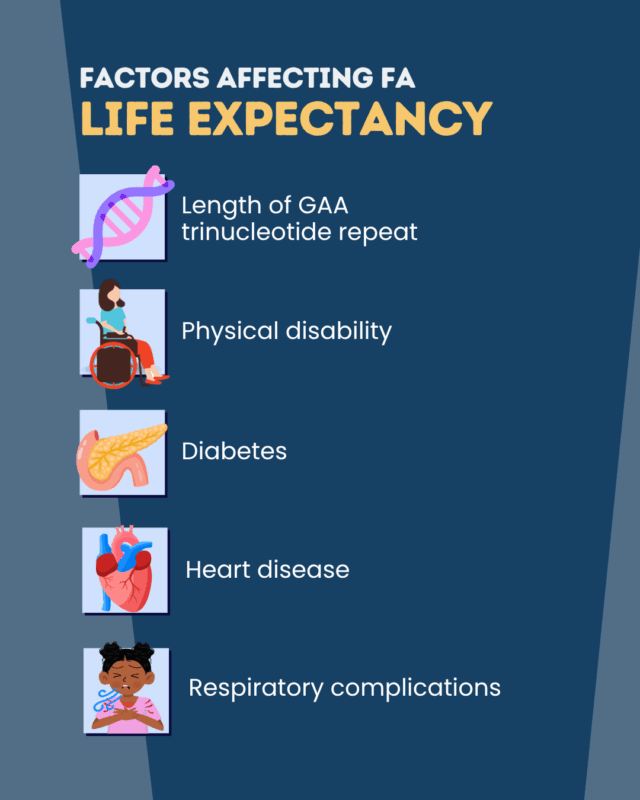Friedreich’s ataxia life expectancy: What to know
Last updated Oct. 30, 2025, by Marisa Wexler, MS

Friedreich’s ataxia is a progressive neurological disorder that can cause life-threatening complications such as heart disease. Survival outcomes vary, and most people with the disease will live into adulthood, but average life expectancy is reduced compared with the general population.
Factors that affect FA life expectancy
Friedreich’s ataxia is caused by mutations in the FXN gene and is the most common of the hereditary ataxias.
In nearly all cases, the disease mutation is a triplet repeat expansion, when three nucleotides (building blocks of DNA) are repeated over and over again. The length of this abnormal expansion is a major predictor of Friedreich’s ataxia prognosis. As a general rule, people with a longer repeat tend to have more severe disease, an earlier age at onset, faster disease progression, and a younger age at death.
Studies have also shown the risk of death is significantly increased in people with Friedreich’s ataxia who have heart disease, diabetes, more severe physical disability, and/or respiratory complications.

Average life expectancy
The average life expectancy for someone with Friedreich’s ataxia is about 35 to 40 years. That said, the Friedreich’s ataxia survival rate varies, with some people living into their 60s or beyond.
In general, life expectancy is closely associated with age at disease onset. People with early-onset Friedreich’s ataxia generally have a shorter life expectancy than those with late-onset Friedreich’s ataxia.
Although no treatment can eliminate the risk of death, multidisciplinary care may help manage the various complications of the disease so patients can be living longer with Friedreich’s ataxia while maximizing their quality of life.
Common health risks to know about
Health risks that may be associated with survival outcomes in Friedreich’s ataxia include:
- heart disease
- diabetes
- physical disability
- respiratory complications.
Heart disease is the most common cause of death for people with the progressive disorder. Fatal Friedreich’s ataxia heart complications include arrhythmia, when the heart’s rhythm is abnormal, and congestive heart failure, when the heart cannot adequately pump blood out to the body. About two-thirds of patients have hypertrophic cardiomyopathy, a condition where the heart is abnormally thickened.
Some heart complications in Friedreich’s ataxia may be managed with medical treatment such as, for example, medications designed to normalize heart rhythms for patients with arrhythmias.
Diabetes, which affects about a third of people with Friedreich’s ataxia, is an independent predictor of survival. Patients with diabetes tend to have shorter life expectancies. People with Friedreich’s ataxia and diabetes are advised to consult specialist care.
Friedreich’s ataxia affects the nervous system and causes problems like difficulty walking. The severity of physical disability has been identified as a predictor of survival risk, with life expectancy shorter for patients who have more extensive physical disability.
In later stages of the disease, Friedreich’s ataxia can cause respiratory problems. Pneumonia (an infection of the lungs) has been reported as a cause of death in Friedreich’s ataxia.
How advancements in care help
Current recommendations suggest people with Friedreich’s ataxia should receive specialist care to manage heart disease, diabetes, and other complications. This can help prevent life-threatening issues and allow patients to improve their quality of life.
The first treatment to slow the progression of Friedreich’s ataxia, Skyclarys (omaveloxolone), was approved in the U.S. in 2023. Data from clinical trials have shown that patients on long-term treatment with Skyclarys still tend to experience disease progression, but at a slower rate than would be expected without treatment. Since this therapy is new, it’s not yet known whether it affects Friedreich’s ataxia life expectancy.
Experimental therapies are being tested in clinical trials, with the hope that these up-and coming advances in Friedreich’s ataxia treatment may help prolong lifespan for people with the disease, but currently it is too early to tell.
Living well with Friedreich’s ataxia
Managing Friedreich’s ataxia is complicated, so it’s recommended patients receive multidisciplinary care from a team of specialists who can help manage the various manifestations of the disease.
Beyond medical management, people living with Friedreich’s ataxia can often benefit from other types of support and care, including:
- physical therapy, which can help with mobility
- occupational therapy, which can offer strategies for navigating day-to-day life
- speech therapy, which can help patients communicate
- regular exercise
- assistive equipment and adaptations
- counseling and support groups to help manage mental health.
Friedreich’s Ataxia News is strictly a news and information website about the disease. It does not provide medical advice, diagnosis, or treatment. This content is not intended to be a substitute for professional medical advice, diagnosis, or treatment. Always seek the advice of your physician or other qualified health provider with any questions you may have regarding a medical condition. Never disregard professional medical advice or delay in seeking it because of something you have read on this website.
Recent Posts
- A gift-giving guide for those who have a loved one with FA
- My FA diagnosis left me ‘thoroughly shaken,’ but I’ve found my resolve
- New MRI approach using AI may offer better picture of FA changes
- Building and maintaining friendships is an intentional act
- Using technology in an FA household to enhance care
